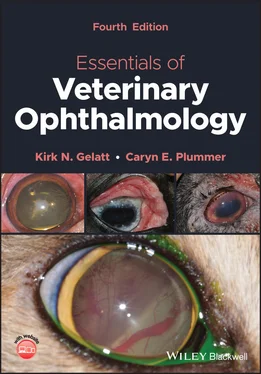DSH, domestic shorthair; DLH, domestic longhair.
Studies in the cat indicate that IOLs for this species should have a power of 52–53 D. The difference between the canine and feline IOL values stems from differences in the anterior chamber depth of the dog and cat.
Astigmatism is a state of unequal refraction of light along the different meridians of the eye. Normally, a given refractive structure of the eye (e.g., the cornea or lens) has a constant curvature radius in all its meridians (though the cornea may flatten toward the limbus). Astigmatism occurs when the horizontal and vertical meridians of the cornea or lens have different curvature radii. Because of these differing curvatures, light entering the eye through the vertical meridian may be refracted more (i.e., direct , or with‐the‐rule , astigmatism ) or less (i.e., indirect , or against‐the‐rule , astigmatism ) than light entering through the horizontal meridian. Astigmatism is diagnosed by refracting the eye in both the horizontal and vertical meridians. A difference of 0.5 D or more in the refractive power of the horizontal and vertical meridians in the same eye is defined as astigmatism.
Several avian and reptilian species possess lower‐field myopia . The eyes of these animals are emmetropic along the horizontal and in the upper visual field, but they become progressively myopic below the horizontal. In other words, different parts of the eye have a different refractive power because the shape of the eye is more like a flattened circle, so that the posterior focal length differs for different meridians. This adaptation can be regarded as a static accommodation mechanism. Hence, the animal shifts its gaze to see the object with the appropriate refractive power, and can match the average viewing distances of different areas of the visual field. This allows the animal to keep the ground in focus with relaxed accommodation while foraging for food and, at the same time, monitor the sky for predators while focused at infinity. The same principle is also found in eyes of pinnipeds, where regional changes in the refractive powers of different parts of the cornea allow these animals to maintain high‐resolution vision in both water and air.
Spherical and Chromatic Aberrations
Spherical Aberrations
The eye is not a perfect optical system. Two of the most significant optical problems that affect the eye are spherical and chromatic aberrations. Positive spherical aberrations occur because in both the cornea and the lens, rays passing through the periphery are refracted more than rays passing through the center. Therefore, rays passing through the periphery are focused closer to the cornea (or lens) than rays passing through its center. Obviously, as the image is not uniformly focused on the retina, the aberration causes blurred vision. A comparative study found significant degrees of spherical aberrations in the lenses of dogs, cats, and rats, but minimal lenticular aberrations in cows, sheep, and pigs.
Emmetropia and Accommodation Underwater
In aquatic species, the cornea is in contact with water rather than air. Because of the very small (∼0.003) difference between the refractive indices of the cornea and water, the cornea of these species has virtually no refractive power. In fact, because the anterior corneal surface has lower curvature than the posterior surface, under water the cornea acts as a weak divergent lens. Fish are forced to compensate for the absence of corneal refraction by increasing the refractive power of other ocular structures, usually the lens. For this reason, as noted earlier, the lenses of fish eyes are very spherical. Their increased curvature results in significantly larger refractive power.
The problem of refraction under water is further complicated in species that move in and out of water because it is physically impossible for an eye to be emmetropic both in air and under water. Eyes that are emmetropic in the air will be hypermetropic under water because the refractive power of the cornea is lost due to its submersion in water. Therefore, species that live and function in both habitats must “choose” whether they will be emmetropic in the air or under water.
Visual Processing: Photoreceptors to Cortex
Retina
The optical part of the visual process ends with photons striking the outer segments of the photoreceptors. The neuronal part of the visual process begins with the capture of these photons and absorption of their energy by the photopigments in the outer segments of the cones and rods, where a chain of biochemical reactions starts. In addition to these sensory neurons, the retina also contains secondary and higher order neurons and an intricate neural circuitry that performs the initial stages of image processing before trains of electrical impulses are transferred through the axons of the retinal ganglion cells (RGCs) to areas in the brain where secondary processing and eventually visual perception occur. A schematic representation of the retina is shown in Figure 2.13.
The outermost cells in the neural retina are the photoreceptors, which are divided into two classes: rods and cones. Rods and cones differ from each other in their morphology, function, and retinal distribution. Functionally, cone systems are characterized by high resolution of fine details, rapid responses, color perception, and low sensitivity to small fluctuations in light intensity. Rod systems are characterized by poor visual resolution and no color perception, but they are extremely sensitive to minute changes in light levels and detection of motion. Therefore, cones are particularly suitable for daylight photopic vision, whereas rods contribute mostly to dim‐light scotopic vision ( Figure 2.14).
Horizontal and Bipolar Cells
The somas of both the horizontal and bipolar cells are located in the inner nuclear layer (INL). Both cells serve as second ‐ order neurons of the retina, connecting, directly or indirectly, the first‐order (photoreceptors) and third‐order neurons (RGCs).
The INL is populated by three more types of cells, in addition to some displaced RGCs. Little is known about the interplexiform cells , which are neurons with processes in both the outer plexiform layer (OPL) and IPL. In the OPL, they are presynaptic to bipolar cells. In the IPL, they are pre‐ and postsynaptic to amacrine cells, and presynaptic to bipolar cells. Thus, it is believed that they may modulate the synaptic gain between photoreceptors and their second‐order neurons. Müller cells are another class of cells found in the INL, and are the main glial cells of the retina. Müller cells are ependymoglial cells, meaning they have both a structural support and a metabolic role.
All information processed by the retina eventually converges on the RGCs, the innermost cell layer in the retina, and its third‐order, final output neuron. Though much signal processing has already occurred in the vertical (photoreceptor to bipolar to RGC) and in the lateral (photoreceptor to horizontal cell to bipolar to amacrine to RGC) pathways, the RGCs are the most complex information processing cells in the retina.
RGC axons constitute the optic nerve fibers. These axons converge at the optic disc, where they are joined in bundles to form the nerve. As the nerve contains RGC axons but no other neuronal cell body, it can be considered a pure white matter tract. However, the nerve does contain several important glial cell populations. These include oligodendrocytes, which contribute to its myelin sheath and formation of nodes of Ranvier, and astrocytes, which have several functions including K +homeostasis and transportation and storage of metabolites (mainly glycogen) used by the axons. RGCs (and some subtypes of amacrine cells) are the only retinal neurons that generate action potentials . Unlike the graded hyperpolarizing or depolarizing responses of other retinal neurons, action potentials are all‐or‐nothing spikes of electrical activity. This means that all of the neuronal processing of the visual signal that has taken place in the retina so far, including information about stimulus size, contrast, color, movement, and location, is coded as alterations in the firing pattern (e.g., short bursts or sustained episodes of firing) and firing rates of the RGCs.
Читать дальше












